Timeline: How the civil rights movement unfolded throughout US history

Timeline: How the civil rights movement unfolded throughout US history
Here's a timeline of the historical events of the civil rights movement that shaped the fight for social justice and against discrimination.
LOS ANGELES - The civil rights movement included a lot significant historical events that shaped the fight for social justice and struggle against prejudice and discrimination. Here is a timeline of the movement citing from History.com, Britannica Encyclopedia, National Parks Service, U.S. Civil Rights Trail, the Civil Rights Digital Library and the Library of Congress.
1863: Abraham Lincoln’s Emancipation Proclamation proclaims that all slaves are free.
1865: The 13th Amendment to the Constitution, prohibiting slavery, is ratified.
1868: The 14th Amendment to the Constitution, granting citizenship and equal civil and legal rights to African Americans and slaves, is ratified.
1866: The “Black Codes” were passed by all white legislators of the former Confederate States. Congress passed the Civil Rights Act, conferring citizenship on African Americans and granting them equal rights to whites.
1870: The 15th Amendment is ratified, giving African Americans the right to vote.
July 26, 1948: President Harry Truman issued Executive Order 9981 to end segregation in the Armed Services.
1950: Ralph Bunche became the first African American to win the Nobel Peace Prize.
May 17, 1954: Brown v. Board of Education effectively ended racial segregation in public schools. However, many schools remained segregated.
Aug. 28, 1955: Emmett Till, a 14-year-old from Chicago, was murdered in Mississippi for allegedly whistling at a white woman. Even though his murderers were acquitted, his death brought international attention to the civil rights movement after “Jet” magazine published a photo of Till’s body at his funeral.
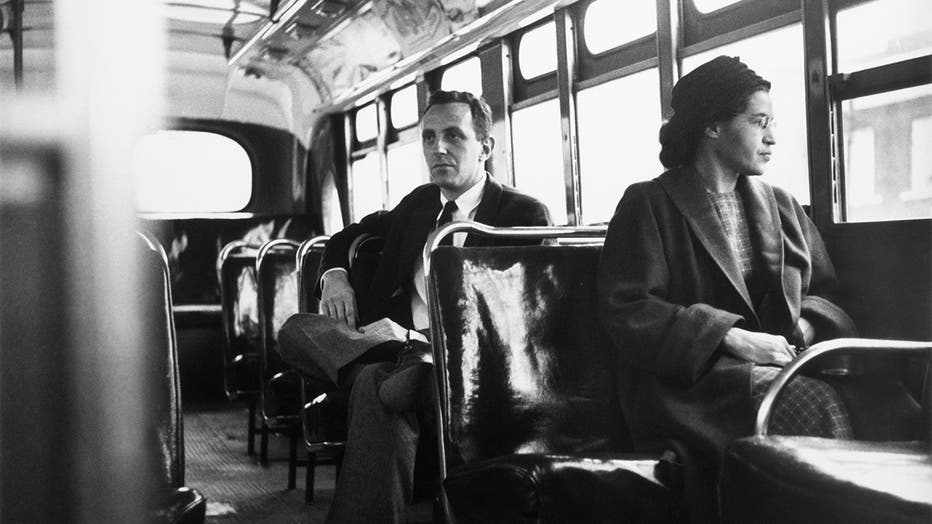
Rosa Parks sits in the front of a bus in Montgomery, Alabama, after the Supreme Court ruled segregation illegal on the city bus system on December 21st, 1956. Parks was arrested on December 1, 1955 for refusing to give up her seat in the front of a b
Dec. 1, 1955: Rosa Parks refused to give up her seat to a white man on a bus in Montgomery, Alabama. Her resistance ignited a year-long Montgomery bus boycott.
Sept. 4, 1957: Nine black students known as the “Little Rock Nine” were blocked from integrating into Little Rock Central High School in Little Rock, Arkansas. President Dwight D. Eisenhower eventually sent federal troops to escort the students, but the harassment continued.
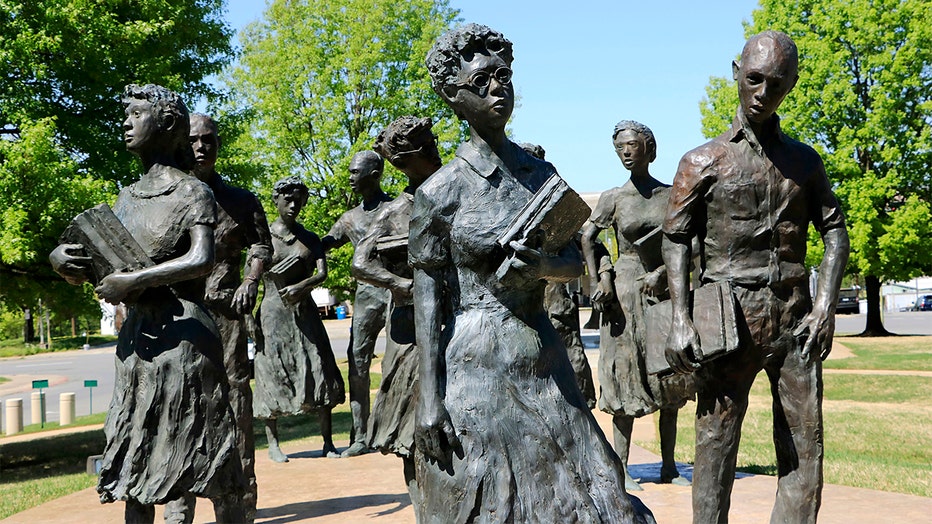
Civil rights memorial sculpture on Arkansas state capitol grounds in memory of the Little Rock Nine school children in 1957. (Photo by: Don & Melinda Crawford/Education Images/Universal Images Group via Getty Images)
Sept. 9, 1957: Eisenhower signed the Civil Rights Act of 1957 into law to help protect voter rights. The law allows federal prosecution of those who suppress another’s right to vote.
1960: Four black college students in Greensboro, North Carolina, launched the lunch counter sit-in movement when they refused to leave a “whites only” lunch counter. Ezell Blair Jr., David Richmond, Franklin McCain and Joseph McNeil came to be known as the “Greensboro Four.”
Nov. 14, 1960: Six-year-old Ruby Bridges became the first black student to attend William Frantz Elementary in New Orleans.
1961: Throughout 1961, black and white activists, known as freedom riders, took bus trips through the American South to protest segregated bus terminals and attempted to use “whites-only” restrooms and lunch counters. The Freedom Rides, marked by horrific violence from white protesters, drew international attention to their cause.
1962: The Voter Education Project began. The VEP coordinated the voter registration campaigns of five civil rights groups: Southern Christian Leadership Conference (SCLC), the Student Nonviolent Coordinating Committee, the National Association for the Advancement of Colored People, the Congress of Racial Equality, and the National Urban League, according to the King Encyclopedia of Stanford University.
June 11, 1963: Alabama Gov. George Wallace stood in the schoolhouse door at the University of Alabama to prevent the registration and enrollment of African American students. The standoff continued until President John F. Kennedy sent the National Guard to the campus.
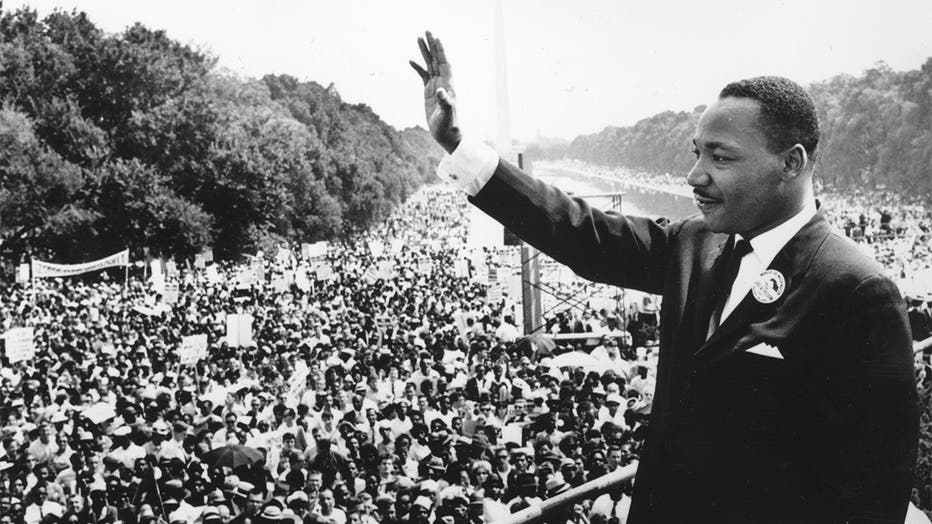
The civil rights leader Martin Luther King (C) waves to supporters on Aug. 28, 1963 on the Mall in Washington D.C. (Washington Monument in background) during the "March on Washington". King said the march was "the greatest demonstration of freedom in
Aug. 28, 1963: Around 250,000 people participated in The March on Washington for Jobs and Freedom. Martin Luther King Jr. gave his “I Have A Dream” speech as the closing address in front of the Lincoln Memorial, stating, “I have a dream that one day this nation will rise up and live out the true meaning of its creed: ‘We hold these truths to be self-evident: that all men are created equal.’”
1963: President Kennedy asked Congress to pass the Civil Rights Act of 1963.
July 2, 1964: President Lyndon B. Johnson signed the Civil Rights Act of 1964 into law, preventing employment discrimination due to race, color, sex, religion or national origin. Title VII of the Act established the U.S. Equal Employment Opportunity Commission (EEOC) to help prevent workplace discrimination.
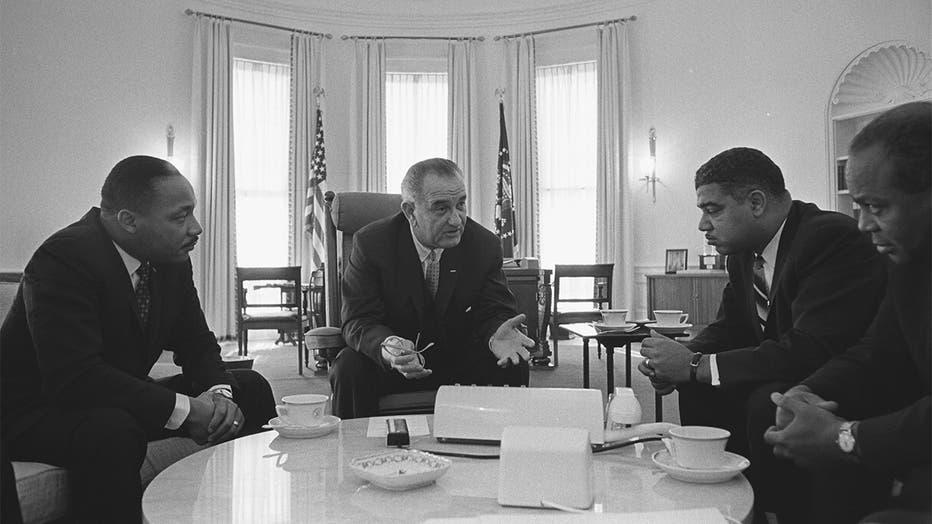
In the Oval Office at the White House, from left, American Civil Rights leader Reverend Martin Luther King Jr (1929 - 1968), US President Lyndon Baines Johnson (1908 - 1973, and Civil Rights activists Whitney Young (1921 - 1971) and James Farmer (192
Feb. 21, 1965: Black religious leader Malcolm X was assassinated during a rally by members of the Nation of Islam.
March 7, 1965: Bloody Sunday. In the Selma to Montgomery March, around 600 civil rights marchers walked from Selma, Alabama to Montgomery—the state’s capital—in protest of black voter suppression. Local police blocked and attacked them. After successfully fighting in court for their right to march, Martin Luther King Jr. and other civil rights leaders led two more marches, finally reaching Montgomery on March 25.
Aug. 6, 1965: President Johnson signed the Voting Rights Act of 1965 to prevent the use of literacy tests as a voting requirement. The law also allowed federal examiners to review voter qualifications and federal observers to monitor polling places.
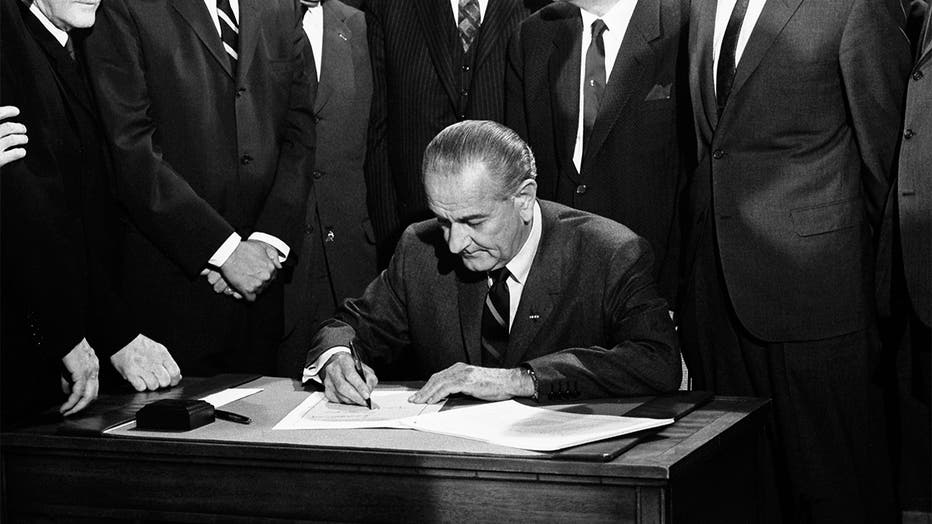
President Lyndon Johnson signs the Civil Rights bill while seated at a table surrounded by members of Congress, Washington DC, April 11, 1968. (Photo by Warren Leffler/Underwood Archives/Getty Images)
1965: The Watts Riot, which began in Los Angeles on Aug. 11, 1965, resulted in millions of dollars worth of damage after a six days.
1966: The Black Panther Party was founded by Huey P. Newton and Bobby Seale in Oakland, California to protect African American neighborhoods from police brutality.
June 12, 1967: The U.S. Supreme Court found Virginia statutes banning interracial marriage unconstitutional in the case Loving v. Virginia. Chief Justice Earl Warren wrote for a unanimous court that the freedom to marry was a basic civil right. The ruling invalidated laws against interracial marriage in Virginia and 15 other states.
April 4, 1968: Martin Luther King, Jr. was assassinated on the balcony of his room at the Lorraine Motel in Memphis, Tennessee. James Earl Ray was convicted of the murder in 1969.
April 11, 1968: President Johnson signed the Civil Rights Act of 1968, also known as the Fair Housing Act, providing equal housing opportunity regardless of race, religion or national origin.
2008: Barack Obama was the first African American to be elected U.S. president.

